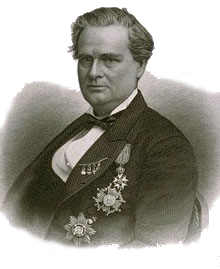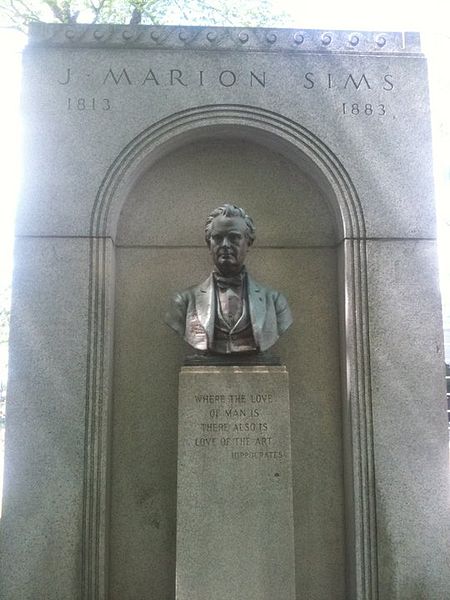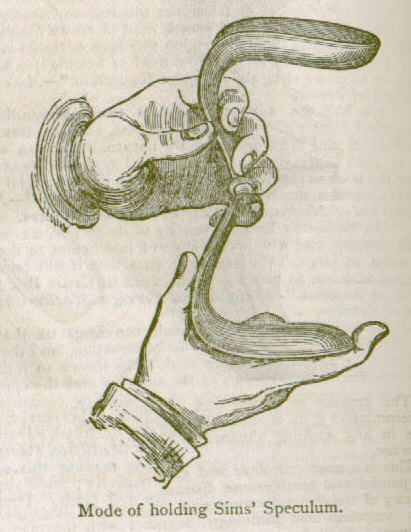<Back to Index>
- Surgeon James Marion Sims, 1813
- Writer Aadne Eivindsson Garborg (Arne Garborg), 1851
- Prime Minister of Belgium Paul Henri Charles Spaak, 1899
PAGE SPONSOR

J. Marion Sims, born James Marion Sims (January 25, 1813 – November 13, 1883) was a surgical pioneer, considered the father of American gynecology. Modern historians argue about his legacy as Sims used slaves as experimental subjects.
Sims was born in Hanging Rock, South Carolina, son of John and Mahala Mackey Sims. Sims's family spent the first twelve years of his life in the Heath Springs area of Lancaster county. He would later write entertainingly of his early school days, but recalled one occasion when he had to be saved from drowning by fourteen year old Arthur Ingram, who lived south of Hanging Rock Creek.
His father, John Sims, was elected sheriff of Lancaster County in 1825 and thereafter took up residence in Lancaster, where the boy, Marion, entered Franklin Academy.
After two years of study at the South Carolina College in Columbia, Sims worked with Dr. Churchill Jones in Lancaster, South Carolina, and took a three month course at the Medical College of Charleston. He then moved to Philadelphia, Pennsylvania, and enrolled at the Jefferson Medical College where he graduated in 1835. He returned to Lancaster to practice, but after the death of his first two patients moved to Alabama.
He returned to Lancaster in 1836 to marry Theresa Jones, the daughter of Dr. Barlett Jones, with whom he had fallen in love while studying at South Carolina College in Columbia. They would return to Alabama together, where in 1845, Marion Sims established a private hospital for women.
Women with vesicovaginal fistulas - usually the result of traumatic labor - were, in those days, social outcasts. No cure was available. In Montgomery, Alabama, Sims treated three Alabamian slave women - Anarcha, Betsy, and Lucy - who were suffering from fistula problems, to develop new techniques to repair this condition or be used as experiments for medical research. From 1845 to 1849 he experimented on them, operating on Anarcha 30 times (it remains unclear if this was necessary due to stitching failure, or if Sims did it deliberately). Although anesthesia had recently become available, Sims did not use any anesthetic during his procedures on Anarcha, Betsy, and Lucy. After the extensive experiments and difficulties, Sims finally perfected his technique and repaired the fistulas successfully in Anarcha. He then repaired several other slave women. It was only after the success of the early experiments on the slaves that Sims attempted the procedure on Caucasian women with fistulas, this time with anesthesia.
These experiments set the stage for modern vaginal surgery. Sims devised instruments including the Sims' speculum to
gain proper exposure. A rectal examination position where a patient is
on the left side with the right knee flexed against the abdomen and the
left knee slightly flexed is also named after him as Sim's position. He insisted on cleanliness. His technique using silver wire sutures led to successful repair of a fistula, and this was reported in 1852. Sims moved to New York in 1853 because of his health and determined to focus on diseases of women. In 1855 he founded the Woman's Hospital, first hospital for women in America. In 1862, during the American Civil War, he moved to Europe, and worked primarily in London and Paris, and from 1863 to 1866, served as surgeon to Empress Eugénie. Honors and medals were heaped upon him for his successful operations in many countries. Under the patronage of Napoleon III, he organized the American - Anglo Ambulance Corps that treated wounded soldiers from both sides at the battle of Sedan. In
1871 Sims returned to New York, and after quarreling with the board of
the Woman's Hospital over the admission of cancer patients (which he
favored), went on to found a new hospital, later to evolve into the
Memorial Center for Cancer and Allied Diseases. He was planning a return visit to Europe when he died of a heart attack on November 13, 1883 in New York. His bronze statue by Ferdinand von Miller the younger, depicting Sims in surgical wear can be found on the peripheral wall of Central Park, at Fifth Avenue and 103rd Street, opposite the New York Academy of Medicine. This is the first statue in the United States depicting a physician. Other memorials can be found on the grounds of the South Carolina State Capitol in Columbia.

